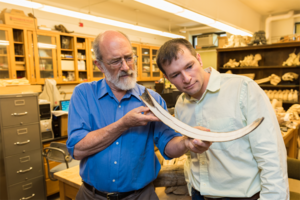Woolly mammoth tusks point to human-caused extinction
The chemical makeup of mammoths tusks indicates that, over the course of about 30,000 years, the animals reached maturity earlier, a common response to predation.

Daniel Fisher, director of the University of Michigan Museum of Paleontology, left, and Michael Cherney, a U-M doctoral student in the Department of Earth and Environmental Sciences, examine a tusk of a juvenile woolly mammoth from Siberia. The tusk was cut along its axis to expose the interior surface.
Daryl Marshke/Michigan Photography
What killed off the woolly mammoths? For decades, paleontologists have debated whether it was human hunting, climate change, or a combination of the two.
The debate remains unresolved, but a novel analysis by two scientists at the department of at the University of Michigan aims to open a new window on that debate.
By collecting chemical samples from tusks of woolly mammoths that lived from about 40,000 years ago to about 10,000 years ago, U-M doctoral student Michael Cherney and his doctoral advisor, U-M Museum of Paleontology director Dan Fisher, found signs that the mammoths had accelerated their maturation process, a common evolutionary response to predation.
"These findings will not end the debate, but we hope they will [show people the promise of a new approach] toward solving a question that, so far, has just led to divided camps," Mr. Cherney said in a press release.
Previous studies have suggested that climate change may have played a significant role in mammoth extinction, as the end of the Pleistocene corresponded with several major warming events.
But Cherney and Dr. Fisher hypothesize that nutritional stress caused by climate change would have prompted juvenile mammoths to be weaned later, which is what happens with elephants. Hunting pressure, by contrast, often prompts animals to mature sooner.
“Age of final weaning is a life-history landmark that is expected to change differently in response to predation and climate-related nutritional stress,” notes the abstract of a paper that Cherney presented at a meeting of the Society of Vertebrate Paleontology in Dallas on Thursday.
The scientists came to this conclusion first by recording the slight changes in chemical structure that occurred during the nursing and then weaning of African elephants at the Toledo Zoo. Noting that modern elephants delay weaning during periods of drought, Cherney and Fisher were curious if a similar trend occurred in Siberian woolly mammoths, too.
To find out, the two scientists examined chemical compounds collected from the tusks of 15 juvenile Siberian woolly mammoth skeletons. They extracted those chemical compounds by making CT scans of those tusk samples.
“A new-born calf, subsisting entirely on its mother's milk, might be expected to form body tissues with a different composition from a much older calf, [who eats] 'adult' food with little input of milk,” Fisher explained to The Christian Science Monitor in an e-mail.
“The process of tusk growth is a lot like writing in a diary, in that the animal forms a layer each day, and what's in that layer, from a chemical point of view, is an indication of the animal's diet and condition at that point in its life. We essentially read this diary by analyzing a succession of tusk layers.”
The tusk specimens Fisher and Cherney examined for the study show that the weaning period decreased, rather than increased, on average, from eight years of age to five over the course of 30,000 years. These findings suggest that overhunting, rather than adaptation to differences in climate or food supply, was the primary factor in the decline and ultimate extinction of the Siberian mammoth population.
“These finding are not necessarily a final answer to the very large question of what caused the extinction of many different kinds of animals over much of the world, around the end of the last ice age, but they show that ... [the extinction] problem people have argued about for more than 150 years can be solved,” Fisher told the Monitor. “It also tells us a lot about human subsistence and lifestyle around this time, as well as about the climate system, [both of which] we can also learn about from tusks.”

